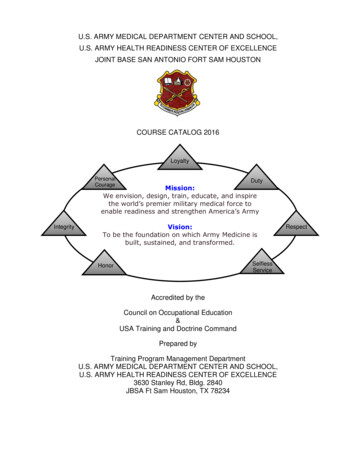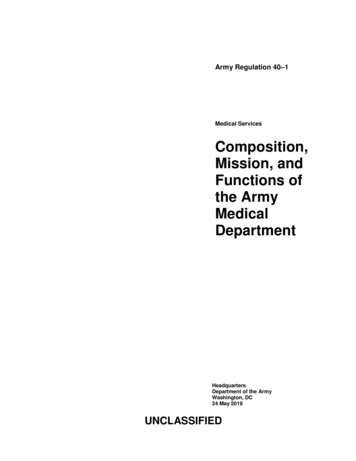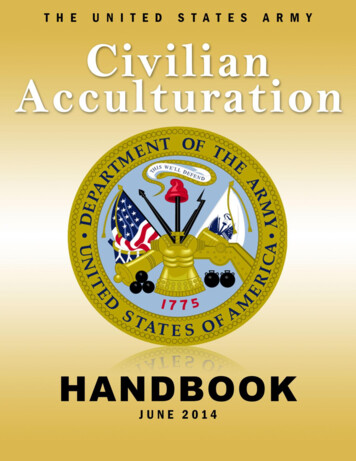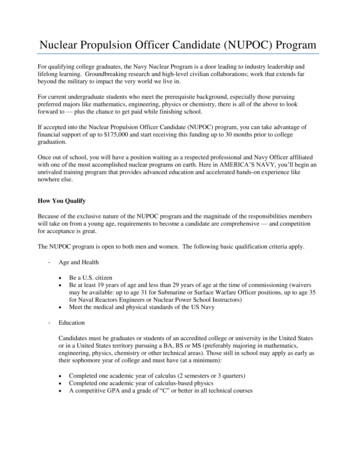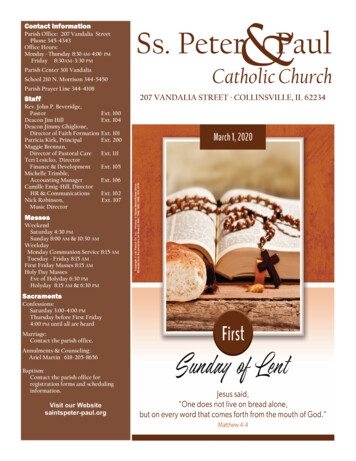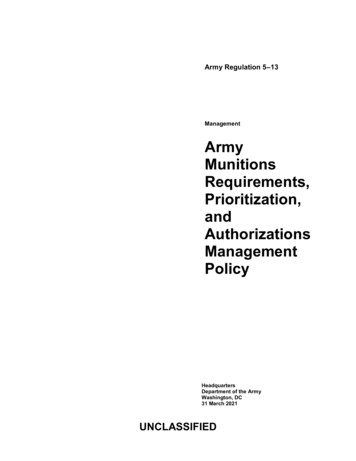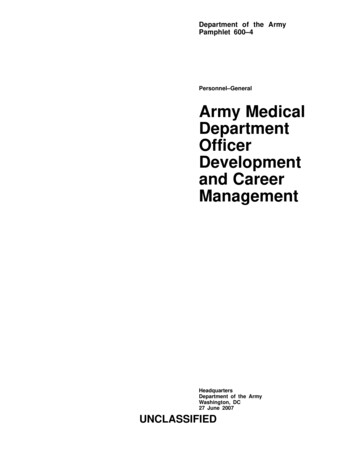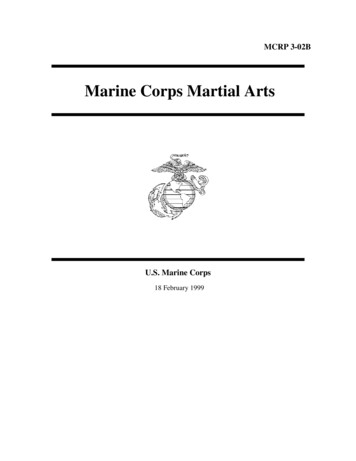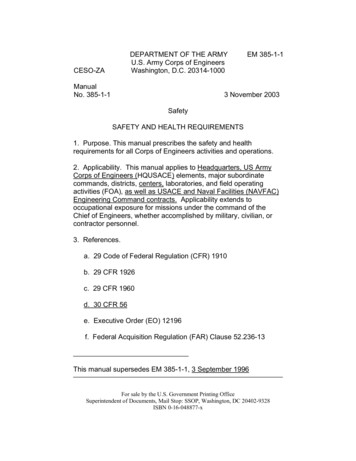
Transcription
DEPARTMENT OF THE ARMYU.S. Army Corps of EngineersWashington, D.C. 20314-1000CESO-ZAManualNo. 385-1-1EM 385-1-13 November 2003SafetySAFETY AND HEALTH REQUIREMENTS1. Purpose. This manual prescribes the safety and healthrequirements for all Corps of Engineers activities and operations.2. Applicability. This manual applies to Headquarters, US ArmyCorps of Engineers (HQUSACE) elements, major subordinatecommands, districts, centers, laboratories, and field operatingactivities (FOA), as well as USACE and Naval Facilities (NAVFAC)Engineering Command contracts. Applicability extends tooccupational exposure for missions under the command of theChief of Engineers, whether accomplished by military, civilian, orcontractor personnel.3. References.a. 29 Code of Federal Regulation (CFR) 1910b. 29 CFR 1926c. 29 CFR 1960d. 30 CFR 56e. Executive Order (EO) 12196f. Federal Acquisition Regulation (FAR) Clause 52.236-13This manual supersedes EM 385-1-1, 3 September 1996For sale by the U.S. Government Printing OfficeSuperintendent of Documents, Mail Stop: SSOP, Washington, DC 20402-9328ISBN 0-16-048877-x
EM 385-1-11 Oct 03g. Department of Defense Instruction (DODI) 6055.1h. DODI 6055.3i. Army Regulation (AR) 40-5j. AR 385-10k. AR 385-114. General.a. The provisions of this manual implement and supplement thesafety and health standards and requirements contained in 29CFR 1910, 29 CFR 1926, 29 CFR 1960, 30 CFR 56, EO 12196,DODI 6055.1, DODI 6055.3, AR 40-5, AR 385-10, AR 385-11,AR 385-40, and FAR Clause 52.236-13. Where more stringentsafety and occupational health standards are set forth in theserequirements and regulations, the more stringent standardsshall apply.b. Mission applicability introduced in paragraph 2 above shallinclude the following:(1) Construction contract work under the provisions of FARClause 52.236-13. Contractors shall comply with the latestversion of EM 385-1-1 (including interim changes) that is ineffect on the date of solicitation. Prior to making an offer,bidders should check the HQUSACE Safety and OccupationalHealth web site (see paragraph c) for the latest changes.No separate payment will be made for compliance with thisparagraph or for compliance with other safety and healthrequirements of this contract. Note: Existing contracts willcontinue to apply the provisions of the previous edition(s) ofthis manual until contract completion.(2) Service, supply, and research and developmentcontracting actions. Compliance with this manual shall be acontract requirement for such activities when technical
EM 385-1-11 Oct 03representatives (proponent in coordination with safety andhealth professionals) advise that special precautions areappropriate.(3) For contracting actions for hazardous, toxic, andradioactive waste site investigation, design, or remediationactivities, compliance with this manual shall be a contractrequirement.c. Copies of this manual are available electronically on theUSACE Safety and Occupational Health Office web site:http://www.hq.usace.army.mil/soh/hqusace soh.htm and inCorps of Engineers Electronic Bid Sets. Hard copies andCD ROM versions of the manual are available from the localcontracting officials.(1) Changes. All interim changes (changes made betweenpublication of new editions) to this manual will be posted onthe Safety and Occupational Health Office web site. Thedate a change is posted will become the official effectivedate of the change.(2) Interpretations. Within the Corps of Engineers,interpretations to the requirements contained within thismanual shall be executed in accordance with the processcontained in Appendix M. Interpretations will apply only tothe specific situation in question and may not be used as aprecedent to determine the meaning of a requirement as itmay apply to another circumstance.(3) Variances. Within the Corps of Engineers, variances toprovisions of this manual require the approval of the Chief ofSafety and Occupational Health, HQUSACE. Variancesshall provide an equal or greater level of protection, shall besubstantiated with a hazard analysis of the activity, and shallbe documented and forwarded through channels to Chief ofSafety and Occupational Health, HQUSACE. The processfor requesting variances is contained in Appendix N.
EM 385-1-11 Oct 03(4) Exceptions. Some of the technical requirements of thismanual may not always be applicable to overseas activitiesdue to conflicting circumstances, practices, and laws orregulations of the locality or the unavailability of equipment.In such instances, means other than the ones specified inthis manual may be used to achieve the required protection.When this occurs, a hazard analysis must be made todocument that the required protection will be achieved by thealternate means.d. Unless otherwise indicated, when publications arereferenced in this manual, the most recent edition is to be used.e. Underlining indicates new or changed text.g. Supplementation of this manual is not authorized except aspublished by the Safety and Occupational Health Office,HQUSACE. Local USACE organizations may develop StandardOperating Procedures (SOPs) to implement the provisionscontained within this manual, but may not implement newrequirements without the specific approval of HQUSACE.Locally developed Safety and Health Requirements will not beincluded in contract requirements without the approval ofHQUSACE. Unified Facilities Guide Specification (UFGS)–01525 will be used in all USACE and NAVFAC contract workunder the provisions of FAR Clause 52.236-13.
EM 385-1-13 Nov 03TABLE OF CONTENTSSectionPage1. Program Management . 1A. General . 1B. Indoctrination and Training. 10C. Physical Qualification of Employees . 13D. Accident Reporting and Recordkeeping. 15E. Emergency Planning . 17F. Emergency Recovery Operations. 182. Sanitation. 19A. General Requirements . 19B. Drinking Water . 19C. Toilets . 21D. Washing Facilities . 23E. Food Service . 24F. Waste Disposal . 25G. Vermin Control . 253. Medical and First-Aid Requirements . 27A. General . 27B. First-Aid Kits. 30C. First-Aid Stations and Infirmaries . 32D. Personnel Requirements and Qualifications . 334. Temporary Facilities . 35A. General . 355. Personal Protective and Safety Equipment. 39A. General . 39B. Eye and Face Protection . 42C. Hearing Protection and Noise Control. 48D. Head Protection . 52E. Respiratory Protection. 54F. Body Belts, Harnesses, Lanyards, and Lifelines Selection of Components . 75G. Electrical Protective Equipment . 77i
EM 385-1-13 Nov 03H. Personal Floatation Devices . 80I. Lifesaving and Safety Skiffs. 846. Hazardous Substances, Agents, and Environments. 87A. General . 87B. Hazardous Substances . 89C. Hot Substances. 95D. Harmful Plants, Animals, and Insects. 97E. Ionizing Radiation. 98F. Nonionizing Radiation and Magnetic andElectric Fields . 108G. Ventilation and Exhaust Systems . 111H. Abrasive Blasting . 112I. Confined Space . 113J. Inclement Weather and Environmental Hazards. 126K. Cumulative Trauma Prevention. 129L. Indoor Air Quality (IAQ) Management. 1317. Lighting . 133A. General . 1338. Accident Prevention Signs, Tags, Labels, Signals,Piping System Identification, and Traffic Control . 137A. Signs, Tags, Labels, and Piping Systems . 137B. Signal Systems, Personnel, and Procedures . 145C. Traffic Control . 147D. Haul Roads . 1479. Fire Prevention and Protection . 163A. General . 163B. Flammable and Combustible Liquids . 168C. Liquefied Petroleum Gas (LP-Gas) . 174D. Temporary Heating Devices. 178E. First Response Fire Protection. 184F. Fixed Fire Suppression Systems. 189G. Fire Fighting Equipment. 190H. Fire Detection and Employee Fire Alarm Systems. 191I. Fire Fighting Organizations - Training and Drilling. 192ii
EM 385-1-13 Nov 03J. Fire Patrols . 193K. USACE Wild Land Fire Control . 19310. Welding and Cutting. 197A. General . 197B. Respiratory Protection. 199C. Fire Protection. 200D. Oxyfuel Gas Welding and Cutting . 202E. Arc Welding and Cutting. 204F. Gas Metal Arc Welding. 20611. Electrical . 209A. General . 209B. Overcurrent Protection, Disconnects, and Switches . 214C. Grounding . 215D. Temporary Wiring and Lighting . 220E. Operations Adjacent to Overhead Lines. 222F. Batteries and Battery Charging . 225G. Hazardous (Classified) Locations . 226H. Power Transmission and Distribution. 229I. Underground Electrical Installations . 244J. Work in Energized Substations. 245K. Communication Facilities . 24712. Control of Hazardous Energy (Lockout/Tagout). 249A. General . 249B. Training . 252C. Periodic Inspections . 253D. Lockout and Tagout Devices. 254E. Applying and Removing Lockout and TagoutDevices. 25513. Hand and Power Tools . 259A. General . 259B. Grinding and Abrasive Machinery . 261C. Power Saws and Woodworking Machinery . 263D. Pneumatic Tools . 265E. Explosive-Actuated Tools. 266iii
EM 385-1-13 Nov 03F. Chain Saws . 268G. Abrasive Blasting Machinery. 26814. Material Handling, Storage, and Disposal. 271A. Material Handling . 271B. Material Storage . 272C. Housekeeping . 275D. Material Disposal . 27615. Rigging. 279A. General . 279B. Wire Rope . 280C. Chain. 284D. Fiber Rope (Natural and Synthetic). 284E. Slings . 285F. Rigging Hardware. 28716. Machinery and Mechanized Equipment . 291A. General . 291B. Guarding and Safety Devices. 298C. Cranes and Derricks - General . 303D. Crawler-, Truck-, Wheel-, and Ringer-MountedCranes. 317E. Portal, Tower, and Pillar Cranes . 321F. Floating Cranes, Floating Derricks, Crane Barges,and Auxiliary Shipboard Mounted Cranes . 324G. Overhead and Gantry Cranes. 331H. Monorails and Underhung Cranes . 332I. Derricks . 332J. Helicopter Cranes . 334K. Material Hoists . 336L. Pile Drivers . 340M. Drilling Equipment. 34217. Conveyors. 347A. General . 347B. Operation . 353iv
EM 385-1-13 Nov 0318. Motor Vehicles and Aircraft. 357A. General . 357B. Operating Rules . 362C. Transportation of Personnel. 365D. All Terrain Vehicles (ATV). 366E. Aircraft. 36719. Floating Plant and Marine Activities . 369A. General . 369B. Access. 382C. Launches, Motorboats, and Skiffs. 385D. Dredging . 388E. Scrows and Barges . 390F. Navigation Locks and Locking. 39120. Pressurized Equipment and Systems . 393A. General . 393B. Compressed Air and Gas Systems . 397C. Boilers and Systems . 401D. Compressed Gas Cylinders . 40221. Safe Access and Fall Protection . 405A. General . 405B. Standard Guardrails and Handrails . 411C. Personal Fall Protection Systems and Safety Nets . 415D. Ladders . 421E. Stairways. 424F. Ramps, Runways, and Trestles. 427G. Personnel Hoists and Elevators. 42722. Work Platforms . 429A. General . 429B. Scaffolds - General. 430C. Metal Scaffolds and Towers. 433D. Scaffolds - Wood Pole. 437E. Scaffolds - Suspended . 443F. Crane Supported Work Platforms. 455G. Form and Carpenter’s Bracket Scaffolds . 463H. Horse Scaffolds. 467v
EM 385-1-13 Nov 03I. Pump Jack Scaffolds . 468J. Elevating Work Platforms. 470K. Vehicle-Mounted Elevating and RotatingWork Platforms . 471L. Mast Climbing Work Platform . 47323. Demolition. 477A. General . 477B. Debris Removal. 480C. Wall Removal. 482D. Floor Removal. 483E. Steel Removal. 484F. Mechanical Demolition . 48424. Floor and Wall Holes and Openings . 487A. General . 48725. Excavations . 489A. General . 489B. Safe Access . 493C. Sloping and Benching . 495D. Support Systems. 496E. Cofferdams. 49926. Underground Construction (Tunnels), Shafts, andCaissons . 507A. General . 507B. Hazardous Classifications . 516C. Air Monitoring, Air Quality Standards, andVentilation. 518D. Fire Prevention and Protection. 524E. Drilling . 528F. Shafts . 529G. Hoisting. 530H. Caissons . 531I. Compressed Air Work. 532J. Underground Blasting . 533vi
EM 385-1-13 Nov 0327. Concrete and Masonry Construction and Steel Erection . 537A. Concrete and Masonry Construction - General . 537B. Formwork and Shoring . 539C. Precast Concrete Operations. 544D. Lift-Slab Operations . 545E. Structural Steel Assembly . 546F. Systems-Engineered Metal Building. 566G. Masonry Construction . 570H. Roofing. 57128. Hazardous Waste Operations and EmergencyResponse (HAZWOPER). 579A. General . 57929. Blasting . 589A. General . 589B. Transportation of Explosive Materials . 594C. Handling of Explosive Materials . 597D. Electromagnetic Radiation . 598E. Vibration and Damage Control . 598F. Drilling and Loading. 600G. Wiring. 603H. Firing . 605I. Post-Blast Procedures . 607J. Underwater Blasting. 60830. Contract Diving Operations. 611A. General . 611B. SCUBA Diving Operations . 620C. Surface Supplied Air Operations . 622D. Mixed-Gas Diving Operations . 624E. Equipment Requirements. 625F. Advanced Diving Technology . 628G. Scientific Snorkeling. 62931. Tree Maintenance and Removal. 631A. General . 631B. Tree Climbing . 633C. Felling . 634vii
EM 385-1-13 Nov 03D. Brush Removal and Chipping . 636E. Other Operations and Equipment. 63732. Airfield Operations . 641A. General . 641AppendicesA – Minimum Basic Outline for Accident Prevention Plan.A-1B – Emergency Recovery Operations.B-1C – Guidelines for Control of Occupational Exposure toCrystalline Silica and Abrasive Blasting . C-1D – Assured Equipment Grounding Conductor Program . D-1E – Woodworking Machinery Guarding .E-1F – Rigging Inspection and Removal Criteria.F-1G – Procedures for the Examination and Qualification ofCrane Operators . G-1H – Crane and Derrick Inspection Criteria . H-1I – Crane Testing Requirements for Performance Tests. I-1J – Ladders, Ramps, Stairs, and Fixed Ladders . J-1K – Cranes, Derricks, and Hooks.K-1L – Scaffolds, Work Stands, and Platforms . L-1M – USACE Process for Requesting Interpretations . M-1N – USACE Process for Requesting Waivers/Variances . N-1O – Manning Levels for Dive Teams. O-1P – Recommended Safe Practices for Tree Maintenance andRemoval Operations .P-1Q – Definitions . Q-1R – Metric Conversion Table . R-1S – References and Resources .S-1Glossary . Glossary -1Index . Index-1Figures1-1 – Position Hazard Analysis . 41-2 – Activity Hazard Analysis . 85-1 – Personal Floatation Devices . 816-1 – PRCS Procedures and Decision Logic . 115viii
EM 385-1-13 Nov 038-1 – Sign and Tag Signal Word Headings. 1518-2 – Example Tag Layout. 1518-3 – Example Sign Layout. 1528-4 – Radio Frequency Warning Symbol . 1558-5 – Laser Caution Sign . 1568-6 – Laser Warning Sign . 1568-7 – Radiological Warning Symbol. 1578-8 – Slow-Moving Vehicle Emblem . 1578-9 – Accident Prevention Tags. 1588-10 – Crane Hand Signals. 1598-11 – Helicopter Hand Signals . 16115-1 – Wire Rope Clip Spacing (Not to be used for slings). 28115-2 – Wire Rope Clip Orientation (Not to be used for slings) . 28115-3 – Wedge Socket Fastening. 28315-4 – Sling Configurations. 28625-1 – Sloping and Benching. 50025-2 – Trench Shields. 50425-3 – Trench Jacks . 50529-1 – Power Firing Systems. 59229-2 – Recommended Installation of Shooting Station andAccessory Arrangement for Using Arcontroller . 592J-1 – Suggested Design for Rungs on Individual-RungLadders. J-2J-2 – Rail Ladder with Bar Steel Rails and Round SteelRungs . J-5J-3 – Clearance for Unavoidable Obstruction at Rear ofFixed Ladder. J-5J-4 – Ladder Far from Wall . J-6J-5 – Deflector Plates for Head Hazards . J-6J-6 – Relationship of Fixed Ladder to a Safe Access Hatch . J-7J-7 – Cages for Ladders More Than 20 ft (6.1 m) High . J-7J-8 – Clearance Diagram for Fixed Ladder in Well . J-8J-9 – Cages - Special Applications . J-9J-10 – Offset Fixed Ladder Sections. J-9J-11 – Slope of Ladders, Ramps, and Stairs . J-13J-12 – Slope of Wood Grain for Job Made Ladders. J-13J-13 – Example of Impermissible Knot Spacing. J-14J-14 – Example of Impermissible Knots at Edge . J-14J-15 – Example of Impermissible Spike Knots. J-12ix
EM 385-1-13 Nov 03J-16 – Cleat Attachment, Single-Cleat Ladder. J-15J-17 – Cleat Attachment, Double-Cleat Ladder . J-16J-18 – Ladder Splices, 2 x 4 Rail . J-17J-19 – Ladder Splices, 2 x 6 Rail . J-18J-20 – Ladder Pitch. J-19J-21 – Methods for Securing Base. J-20K-1 – Mobile and Locomotive Cranes.K-1K-2 – Construction Tower Cranes.K-8K-3 – Overhead and Gantry Cranes .
EM 385-1-1 1 Oct 03 g. Department of Defense Instruction (DODI) 6055.1 h. DODI 6055.3 i. Army Regulation (AR) 40-5 j. AR 385-10 k. AR 385-11
